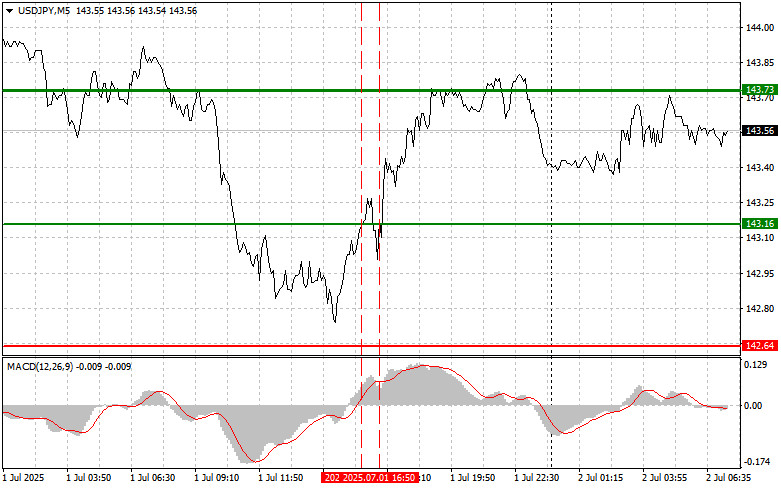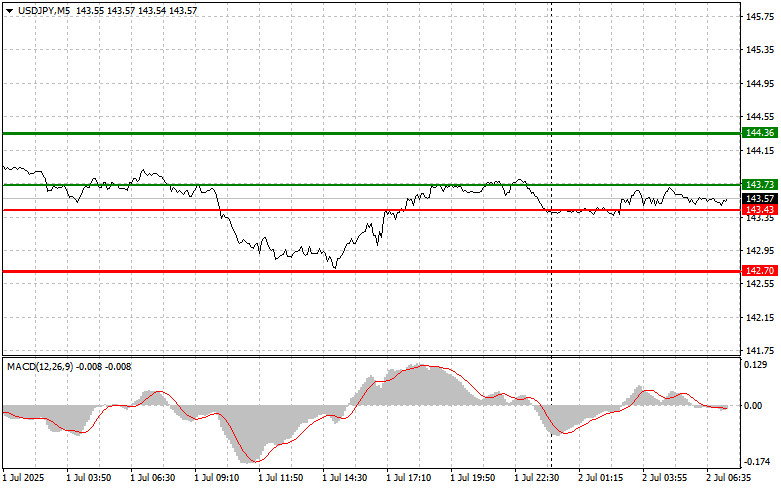Analysis of Trades and Trading Tips for the Japanese Yen
The 143.16 price test occurred when the MACD indicator had already moved significantly above the zero mark, which limited the dollar's upside potential. For this reason, I did not buy the dollar. The second test of 143.16 happened while the MACD was in the overbought zone, which allowed sell scenario #2 to unfold. However, this trade ended in a loss.
Yesterday's comments by the Federal Reserve Chair that the committee is not planning to lower interest rates due to concerns about a sharper rise in U.S. inflation helped strengthen the dollar against the Japanese yen. This factor, along with the overall stability of the U.S. economy, reinforces the dollar's status as a safe-haven asset. The yen is also under pressure from expectations that the Bank of Japan will maintain a wait-and-see approach due to the risk of trade restrictions imposed by the United States.
Today's data on changes in Japan's monetary base was ignored, as it matched economists' forecasts exactly. Investors appear to be focusing on more significant factors such as the global economic environment and the future course of the BOJ's monetary policy. In particular, the lingering uncertainty surrounding the pace of global economic recovery and the potential impact of trade wars continues to weigh on investor sentiment. These external factors typically carry more weight for Japan's export-oriented economy than internal monetary supply figures.
For intraday strategy, I will focus primarily on implementing Scenarios #1 and #2.
Buy Scenario
Scenario #1: I plan to buy USD/JPY today at the entry point around 143.73 (green line on the chart), aiming for a rise to 144.36 (thicker green line on the chart). Around 144.36, I plan to exit long positions and open short positions on a reversal, targeting a 30–35-pip pullback from that level. It is better to buy the pair on corrections and sharp dips in USD/JPY.
Important: Before purchasing, ensure the MACD indicator is above the zero line and is just starting to rise from it.
Scenario #2: I also plan to buy USD/JPY today in the event of two consecutive tests of the 143.43 level, when the MACD is in the oversold zone. This will limit the downside potential of the pair and lead to a market reversal upward. A rise toward the opposite levels, 143.73 and 144.36, can be expected.
Sell Scenario
Scenario #1: I plan to sell USD/JPY today only after it breaks below the 143.43 level (red line on the chart), which will likely lead to a sharp decline in the pair. The main target for sellers will be 142.70, where I plan to exit short positions and open buy positions on a rebound (targeting a 20–25-pip reversal from that level). Selling pressure may quickly return today.
Important: Before selling, ensure the MACD indicator is below the zero line and is just starting to decline from it.
Scenario #2: I also plan to sell USD/JPY today in the event of two consecutive tests of the 143.73 level, while the MACD is in the overbought zone. This will limit the pair's upside potential and lead to a downward market reversal. A decline toward the opposite levels, 143.43 and 142.70, can be expected.
What's on the Chart:
- The thin green line represents the entry price where the trading instrument can be bought.
- The thick green line indicates the expected price level where a Take Profit order can be placed, or profits can be manually secured, as further price growth above this level is unlikely.
- The thin red line represents the entry price where the trading instrument can be sold.
- The thick red line indicates the expected price level where a Take Profit order can be placed, or profits can be manually secured, as further price decline below this level is unlikely.
- The MACD indicator should be used to assess overbought and oversold zones when entering the market.
Important Notes:
- Beginner Forex traders should exercise extreme caution when making market entry decisions. It is advisable to stay out of the market before the release of important fundamental reports to avoid exposure to sharp price fluctuations. If you choose to trade during news releases, always use stop-loss orders to minimize potential losses. Trading without stop-loss orders can quickly wipe out your entire deposit, especially if you neglect money management principles and trade with high volumes.
- Remember, successful trading requires a well-defined trading plan, similar to the one outlined above. Making impulsive trading decisions based on the current market situation is a losing strategy for intraday traders.














